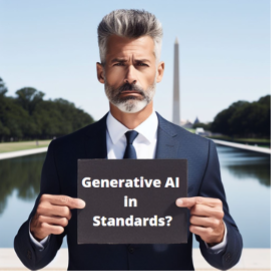Author
Brandon White | VP, Marketing & Business Development | Techstreet

Photo by: DALL·E 3 (Microsoft Bing)
Is this photo real or fake?
To grab attention and illustrate the ease of Generative Artificial Intelligence, I leveraged open source GenAI. The photo above is a photorealistic image and is an example of what Generative AI can create. It is a person that does not exist. The image was created using a Generative AI model called DALL-E 3 and this powerful tool can create new images from text descriptions. It can also be used to edit existing images or to generate variations on existing images. DALL-E 3 is still under development, but it has the potential to revolutionize the way we create and consume images. It could be used to create new forms of art and entertainment, or to develop new tools for education and research. Or as illustrated in one morning session this past week, can be used to create deep fakes and cause IP complications.
2023 World Standards Week
World Standards Week always creates buzz in the standards industry and this year was no different. Last week I was able to spend some time in Washington, DC, attending ANSI sponsored sessions and had the pleasure of supporting an opening reception with our colleagues at SES. The energy was high as there are many initiatives, challenges, and changes being addressed – this week brought out the best of the best. I’ll share details in this and subsequent Blogs.
DAY 1 – Generative AI: Rewriting the Future?

Photo by: DALL·E 3 (Microsoft Bing)
Tuesday, October 10, 2023, was focused on the trending topic of Generative AI. Generative AI, also known as GAI or GenAI, is a rapidly developing field with the potential to significantly impact the future of standards development, implementation, and consumption.
The day opened with a keynote address by Joe Bhatia, President and CEO of the American National Standards Institute (ANSI). Bhatia emphasized the importance of standards in ensuring the safe and responsible development and use of generative AI. He noted that standards can help to ensure that generative AI systems are fair, unbiased, and accountable.
In the first session, the baseline was set with the presentation “AI 101 Understanding of Generative AI and Large Language Models,” which got everyone up to speed. After this we jumped into the second session, “Exploring the Power of Generative AI: Expert Perspectives.” This topic featured a panel of experts from industry, government, and academia. The panelists discussed the potential benefits and risks of generative AI, as well as the need for responsible development and use.
The panelists emphasized that generative AI systems should be trained on a diverse set of data to avoid bias and discrimination. They also noted that it is important to have a diverse team of people involved in the development and use of generative AI systems.
Another key theme of the panel discussion was the need for transparency and accountability in the use of generative AI. The panelists emphasized that it is important to be able to understand how generative AI systems work and to be able to hold them accountable for their outputs.
The following session of the conference, “Generating the Future: Impact Across Sectors,” featured a panel of experts from different industries who discussed how generative AI is being used in their sectors and the potential impact of the technology in the future.
The panelists discussed a wide range of applications for generative AI, including:
Healthcare: Generative AI can be used to develop new drugs and treatments, personalize patient care, and improve the efficiency of healthcare systems.
Fintech: Generative AI can be used to detect fraud, develop new financial products, and improve customer service.
Retail: Generative AI can be used to personalize product recommendations, improve supply chain management, and create new shopping experiences.
The panelists also discussed the potential challenges and risks of using generative AI in their sectors. One of the key challenges is the need to ensure that generative AI systems are fair and unbiased. Another challenge is the need to protect the privacy and security of data used to train and operate generative AI systems.
The final session of the conference, “Trustworthy and Responsible AI,” featured a panel of experts who discussed the importance of developing and using generative AI in a responsible way. The panelists emphasized the need for transparency, accountability, and fairness in the development and use of generative AI. They also discussed the need to develop policies and regulations to govern the use of generative AI.
Overall, day one of World Standards Week provided a valuable opportunity to learn about the potential benefits and risks of generative AI, as well as the need for responsible development and use. The conference also highlighted the importance of standards in ensuring the safe and responsible development and use of Generative AI.
Reflections on day one of the Conference
I left day one of World Standards Week with several thoughts and reflections on the future of Generative AI.
First, it’s clear that Generative AI has the potential to transform many industries and aspects of our lives. Generative AI can be used to develop new products and services, improve existing products and services, and automate tasks that are currently performed by humans.
Second, it is important to develop and use generative AI in a responsible way. Generative AI systems can be biased and discriminatory, and they can also be used to create harmful content. It is important to have policies and regulations in place to govern the development and use of generative AI.
Third, standards will play an important role in ensuring the safe and responsible development and use of generative AI. Standards can help to ensure that generative AI systems are fair, unbiased, and accountable.
I am excited to see how generative AI is used to improve our lives in the years to come. However, it is important to be mindful of the potential risks and challenges associated with this technology. We must work together to ensure that generative AI is developed and used in a responsible way. I’ll leave you with the fake photo below to drive this point home….

Photo by: DALL·E 2 OpenAI (Canva)
Author
Brandon White | VP, Marketing & Business Development | Techstreet



